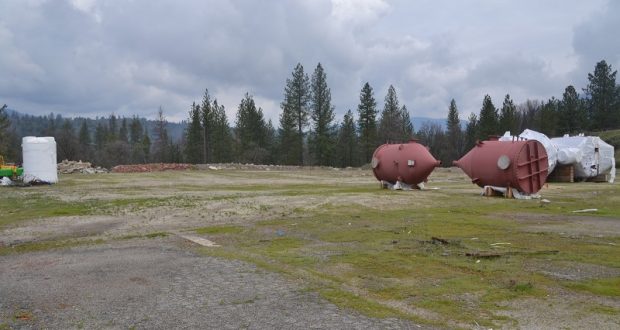NORTH FORK — PG&E’s bankruptcy has stalled construction of a new biomass plant, a key component in a plan to boost the local economy.
“Right now, we’re in a holding pattern,” said North Fork Community Development Council (CDC) President Dan Rosenberg.
Rosenberg has been working on the project for seven years.
“I used to tell people we’d be operational by 2017,” he said. “That used to sound like so far into the future. Nowadays, I’m not making any more projections.”
Greg Stangl, project developer for Phoenix Energy, the Bay Area company partnering with the CDC to build the biomass plant, said PG&E’s Jan. 14 Chapter 11 bankruptcy filing could not have come at a worse time for the project.
Stangl said North Fork Community Power — the joint venture’s official name — was on the verge of closing a $15 million bond sale needed to finance plant construction when PG&E filed for bankruptcy. Now the bankruptcy casts a shadow over the utility’s ability to honor previously signed contracts, including power purchase agreements (PPAs).
Stangl believes PG&E did not need to declare Chapter 11 and called the bankruptcy “fake.” But he conceded the utility’s filing has “really put a wrinkle in our plan.”
Spokesman Denny Boyles said this week that while PG&E remains “committed to helping California achieve its clean energy goals,” as part of the Chapter 11 filing, the utility has “made no decisions as to whether to assume or reject” previously signed PPAs.
“PG&E has no basis to reject our contract,” Stangl said.
“It’s been incredibly frustrating dealing with them,” Rosenberg added. “PG&E has put up so many roadblocks.”
The joint venture plans to sell PG&E electricity for about 20 cents per kilowatt — “way more expensive” than the utility’s other sources, Rosenberg admits.
“But there’s a reason the state passed a law forcing PG&E to buy power from projects like ours,” he added. “Our plant promotes environmental sustainability, reduces forest waste and the chances of future fires. And it will help reinvigorate a rural community.”
The low bidder in a public auction conducted through PG&E’s BioMAT Program, Phoenix is a 50-50 partner with the CDC in the biomass plant, which will occupy about 10.5 acres at the Old Mill site, once a Superfund site and now the focus of a redevelopment plan creating new residential and commercial opportunities in North Fork.
The BioMAT Program was established by Senate Bill 1122 and signed into law in 2012. The program adds an additional 250 MW of capacity for investor-owned utilities to offer so-called ‘feed-in’ PPAs for eligible projects in California like the North Fork plant.
“Twenty percent of the additional capacity must come from projects that rely on forestry sources” to help deal with the tree mortality crisis in the Sierra, Stangl said.
“What we need most is for PG&E to connect us to the grid and even that’s a process they’ve told us could take anywhere from three months to a year and a half,” Rosenberg said.
Late this week, PG&E named a new president and CEO and also replaced much of its corporate board.
The management shakeup, according to a press release, will “bring fresh perspectives, experience and expertise” to the company, which is the single-largest electric utility in the U.S. and currently supplies more than 5.2 million California households with power.
The joint venture has already put about $4 million into the project, Stangl said, and needs to sell $15 million in tax-exempt bonds to finish construction.
Phoenix Energy is a so-called “private label” power company that builds, owns and operates biomass gassification plants in partnership with ag, waste and forestry-related businesses.
The North Fork plant will use large gas engines to convert dead trees into electricity, which will be sold to PG&E and then distributed to North Fork area homes and businesses.
Stangl said the 24-hour-a-day gassification process “bakes” rather than “burns” the dead trees, limiting air pollution and producing a solid carbon by-product called bio-char, which the joint venture plans to sell to area farmers for use as an additive to help soil retain more water.
The plant will create at least 12 new local jobs, Stangl said.
“Our equipment is just sitting out there waiting.”




